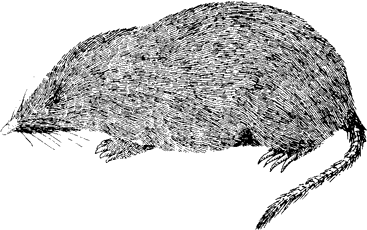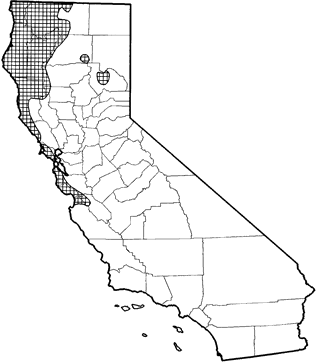
Shrew-mole
Distribution, Abundance, and Seasonality
The shrew-mole is common from Del Norte and Siskiyou cos. south to northern Monterey Co. Isolated populations occur in Shasta and Plumas cos. Optimal habitats are Douglas-fir, redwood, mixed conifer, montane hardwood and montane riparian with dense, moist understories. Also found in wet meadow and fresh emergent wetland habitats. Generally found below 250 m (800 ft), but recorded to 2500 m (8000 ft).

Range Map
Specific Habitat Requirements
Feeding: The shrew-mole's diet has been reported to contain 42-49% earthworms, 12-43% insects and other invertebrates, and small amounts of vegetation and other materials (Dalquest and Orcutt 1942, Terry 1978, Whitaker et al. 1979). Forages in subsurface runways, shallow burrows, litter and understory vegetation. Shrew-moles have been observed climbing in shrubs.
Cover: Uses shallow burrows (maximum depth of 30 cm (1 ft)), litter, stumps, logs, and dense, moist undercover for shelter.
Reproduction: Nest consists of damp leaves in an underground burrow. Occasionally may nest above ground in a stump or log.
Water: Obtains water from earthworm and insect prey.
Pattern: Prefers forests with dense, moist undercover such as Oregon grape or swordfern (Terry 1981). Damp ravines in forest habitat are preferred, and open areas are avoided. Friable, well-drained soils are preferred, but this species may be common in swampy areas as well. Populations are reduced by logging and grazing.
Species Life History
Activity Patterns: Yearlong activity, both diurnal and nocturnal.
Seasonal Movements / Migration: None reported.
Home Range: Densities of 5-6 per 0.4 ha (1 ac) are reported in good habitat (Verner and Boss 1980).
Territory: Unlike other moles, the shrew-mole apparently is not territorial (Dalquest and Orcutt 1942), and has been reported to travel in loose groups.
Reproduction: Young may be born at any time from February through November, with a peak in births from March through May. Reported average litter sizes are 3 (range 1-4) (Dalquest and Orcutt 1942) and 2-3 (range 1-4) (Cowan and Guiguet 1965). There may be several litters per year. Although the breeding season is long, only a small fraction of the population is breeding at any one time.
Niche: This small, agile mole prefers forest habitats to a greater extent than other moles. Owls probably are the main predators of shrew-moles, but the Pacific giant salamander and rubber boa also are known to prey on shrew-moles (Maser et al. 1981).
Sources & References
California Department of Fish and Game, 1999.
California's Wildlife, Sacramento, CA.
Written by: G. Hoefler, J. Harris, reviewed by: H. Shellhammer, edited by: S. Granholm
Cowan, I. McT., and C. J. Guiguet. 1965. The mammals of British Columbia. Handb. B.C. Provincial Mus. 11:1-414. Dalquest, W. W. 1948. Mammals of Washington. Univ. Kans. Publ., Mus. Nat. Hist. 2:1-444. Dalquest, W. W., and D. R. Orcutt. 1942. The biology of the least shrew-mole, Neurotrichus gibbsii minor. Am. Midl. Nat. 27:387-401. Maser, C., B. R. Mate, J. F. Franklin, and C. T. Dyrness. 1981. Natural history of Oregon coast mammals. Pac. Northwest For. And Range Exp. Sta., USDA, For. Serv., Gen. Tech. Rep., PNW-133. 496pp. Nowak, R. M., and J. L. Paradiso. 1983. Walker's mammals of the world. 4th ed. 2 vols. John Hopkins Univ. Press, Baltimore, MD. 1362pp. Racey, K. 1929. Observations on Neurotrichus gibbsii gibbsii. Murrelet 10:61-62. Terry, C. J. 1978. Food habits of three sympatric species of insectivora in western Washington. Can. Field-Nat. 92:38-44. Terry, C. J. 1981. Habitat differentiation among three species of Sorex and Neurotrichus gibbsii in Washington, USA. Am. Midl. Nat. 106:119-125. Verner, J., and A. S. Boss. 1980. California wildlife and their habitats: Western Sierra Nevada. USDA, For. Serv. Gen. Tech. Rep. PSW-37. 439pp. Whitaker, J. O., Jr., and C. Maser, and R. J. Pedersen. 1979. Food and ectoparasitic mites of Oregon moles. Northwest Sci. 53:268-273. Williams, D. F. 1975. Distribution records for the shrew-mole, Neurotrichus gibbsii. Murrelet 56:2-3.
California Animal Facts | California's Wildlife